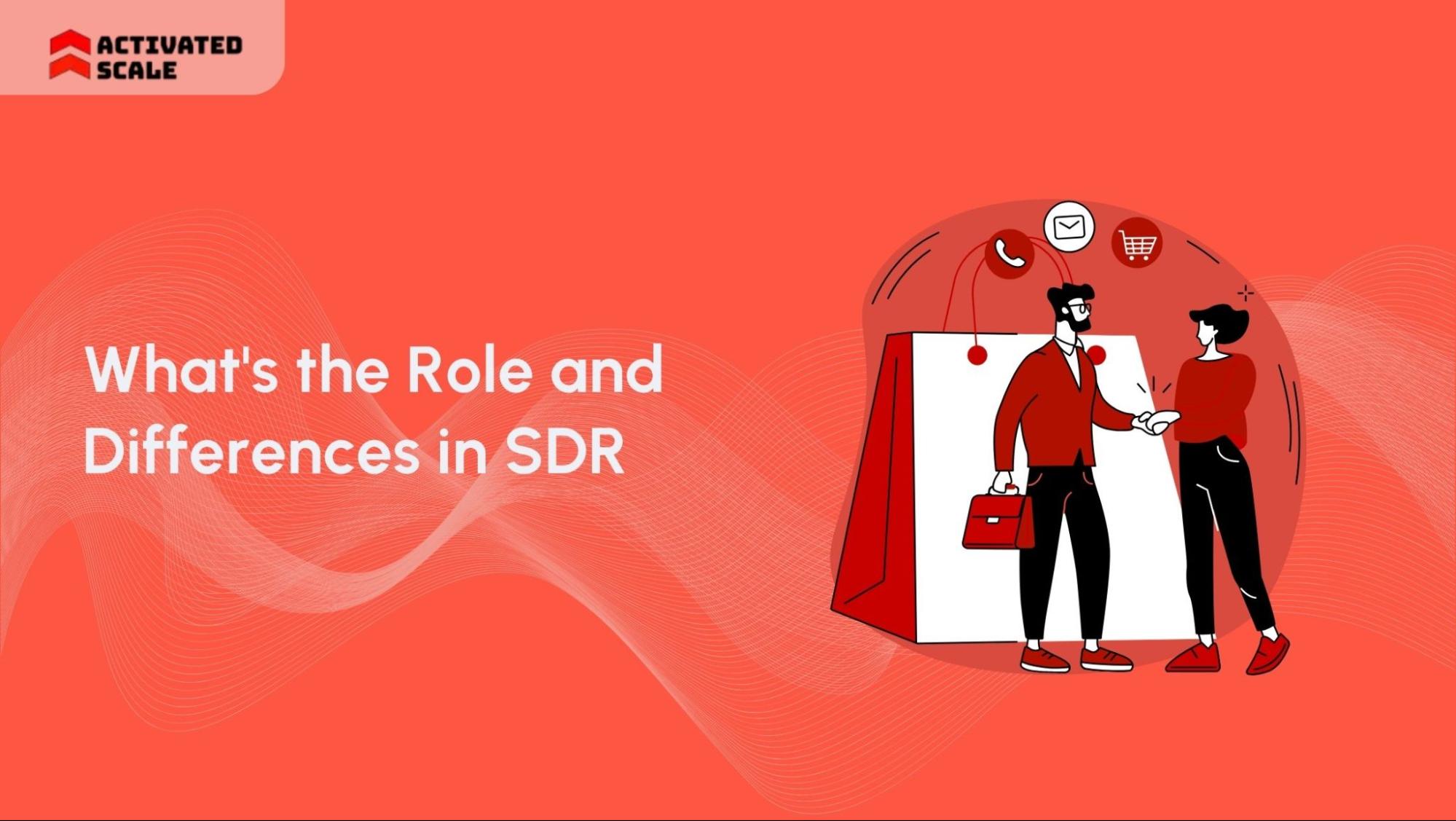In a world where customer expectations shift overnight, the businesses that win aren't just the ones with the best product. The successful ones are the ones with the most strategic sales ideas and the right reps.
If your team is still juggling lead generation, qualification, and closing all at once, they're spread too thin. This is why the most forward-thinking companies are recruiting Sales Development Representatives (SDRs). You may already know what does an SDR mean?
However, you must know whether you need to hire one or not. Research shows that organizations with a structured SDR team can do better in qualifying leads.
You might be asking: "How do I integrate this into my existing team without causing chaos?" That's why in this blog, we’ll be your guide.
Key Takeaways
- SDRs qualify inbound leads and schedule meetings for AEs, setting up deals but not closing them.
- SDRs focus on inbound leads, while BDRs target outbound prospects and build long-term relationships.
- Hire when you have a high volume of inbound leads needing quick qualification and funnel management.
- Strong communication, active listening, product knowledge, and proficiency with CRM/tools are essential.
- The average SDR salary in the U.S. is $57,739, with the role being entry-level and focused on lead generation.
What Does an SDR Mean?
Sales Development Representatives (SDRs) are the backbone of the sales funnel. At the heart of their role is one key objective: To qualify leads. But what does that actually involve?
Simply put, SDRs focus on identifying potential prospects from inbound inquiries, ensuring they’re the right fit for the product or service. They don’t close deals themselves but play an essential role in setting up Account Executives (AEs) for success.
The primary responsibilities of an SDR include:

1. Qualifying Inbound Leads
SDRs assess whether leads are a good fit for the company’s offerings by analyzing factors such as company size, industry, and needs. This helps identify leads that align with the company’s ideal customer profile (ICP), ensuring that only the most promising prospects move forward.
2. Scheduling Meetings for AEs
Once a lead is qualified, the SDR initiates meaningful conversations to engage the prospect and sets up meetings for the Account Executives (AEs) to close deals. This is done through various outreach methods like cold calls, emails, and LinkedIn messages.
3. Handling the Initial Stages of the Sales Funnel
SDRs manage the early stages of the sales process by nurturing leads before handing them off to AEs. They ensure that leads are engaged, informed, and ready for deeper conversations that ultimately lead to conversion.
4. Active Listening
SDRs need to practice active listening to understand customer needs, challenges, and pain points. If you pay attention to the details shared by prospects, you can better customize their communication. In this way, they can also propose relevant solutions that resonate with the lead.
5. Better organization
Effective SDRs manage lead information and outreach strategies efficiently. They keep track of conversations, follow-ups, and sales data to ensure no opportunity is overlooked and that the outreach process is streamlined.
6. Better resilience
Dealing with rejection is part of the job, and SDRs need to stay resilient. They need to maintain a positive mindset and continue to engage prospects despite setbacks. It keeps the sales momentum going and increases the chances of eventually closing deals.
When executed well, the work of an SDR directly influences the effectiveness of your sales team, driving better growth. So we know what an SDR does. But you've probably also heard the term 'BDR' thrown around. Are they the same thing?
Business Development Representatives (BDRs) are fantastic for outbound hustle, but they're only one part of the equation. So, how do you know which role is the right fit to supercharge your specific goals?
To find that out, you must know how they differ in different aspects of sales.
Read Also: Understanding the Role and Process of a Sales Development Representative
What are the Differences Between SDR and BDR
Before we go in-depth in our discussion, let’s first understand why you should even care.
You know you need specialized roles to grow, but which one?
While the titles are often used interchangeably, SDRs and BDRs play fundamentally different games. Getting this wrong can stall your pipeline. That’s why let's cut through the confusion and break down the key differences:
An SDR and a BDR are both vital, but they're not interchangeable. The right choice acts as a force multiplier for your unique growth goals. So, how do you diagnose your needs?
The signs are clearer than you think. We'll help you spot the undeniable clues to determine the right time to hire an SDR to crack open new markets.
Read Also: Steps to Build and Train a Successful SDR Team
When to Hire an SDR?
Not sure when to hire? Your sales pipeline has the answer. The question is, are you listening? Instead of getting lost in definitions, look closely at your current sales process.
Here’s the guide that will help you choose an SDR as your top priority:

- High volume of inbound leads: If your marketing campaigns are generating a lot of inbound traffic and leads, hiring an SDR is your solution. They will help qualify and move these leads through the pipeline quickly.
- Need for quick lead qualification: When speed and efficiency are essential in identifying potential customers, SDRs excel at rapidly qualifying inbound leads.
- Focus on organizing the early sales funnel: If your sales team is overwhelmed with lead qualification tasks, an SDR can take that burden off your AEs. It will enable them to focus on higher-value activities like closing.
Activated Scale can help you find the right talent. We offer flexible hiring solutions, including Contract-to-Hire Sales Recruiting, to ensure your sales team has the right SDR in place.
To be honest, you need to choose SDR very carefully. From top skills to using new technologies, your team of SDRs should be able to fill your pipeline better.
Key Skills Your Sales Development Representatives Should Have
A perfectly qualified lead finally responds to your outreach. They're interested, but hesitant. The next conversation will make or break the opportunity. In this moment, it’s the skill of your Sales Development Representative that wins the day.
Here are the five skills you need in your SDRs:
1. Clear understanding of their role
A successful SDR knows their responsibilities and how they contribute to the sales pipeline. They should be familiar with performance metrics to maximize impact. Below is a list of key performance metrics you should be aware of:
- Activity Metrics
These measure the volume of work an SDR is doing and ensure they’re consistently engaging with prospects. Typical activity metrics include:
- Number of calls made
- Number of emails sent
- Number of LinkedIn messages or other outreach attempts
Tracking activity ensures SDRs are putting in the necessary effort to generate opportunities, even before outcomes are visible.
- Pipeline Contribution
This measures the SDR’s ability to move leads into the sales funnel:
- Number of qualified leads added: Leads that meet your company’s criteria for potential buyers.
- Number of meetings booked: How many meetings they secure for account executives (AEs).
- Number of qualified meetings: Meetings with leads that are likely to convert, showing the SDR’s ability to focus on quality, not just quantity.
This metric reflects the SDR’s real impact on future revenue. Learning from experienced colleagues can accelerate skill development and help refine strategies.
2. Deep product and customer knowledge
Effective SDRs understand the company’s offerings and how they solve customer challenges. They know the target audience, their needs, and which clients deliver the most value. This insight allows for personalized messaging, more meaningful conversations, and higher engagement rates.
3. Strong communication and interpersonal skills
SDRs need to write and speak clearly, craft compelling messages, and actively listen to prospects. Emotional intelligence is key to positioning themselves as trusted advisors rather than just salespeople.
4. Workflow management
Juggling multiple leads, outreach efforts, and follow-ups requires time management and organizational skills. SDRs benefit from structured workflows and strategies like time blocking or segmenting tasks for maximum efficiency.
Productivity tools, automation, and CRM systems can make their processes smoother.
5. Essential tools to master
To perform efficiently, SDRs should be comfortable with:
- CRM systems (like Salesforce or HubSpot) to track leads, manage contacts, and log interactions.
- AI tools (like Einstein) for prospect research, personalized email drafting, and identifying high-potential accounts.
- Communication tools (Slack, Zoom, email platforms) to coordinate with colleagues and engage prospects.
- Sales engagement tools (like Outreach or SalesLoft) to automate cadences, schedule follow-ups, and monitor response rates.
Mastering these tools ensures SDRs spend less time on repetitive tasks and more time connecting with qualified prospects.
Armed with these skills and metrics, the next logical question is: What does the profile of a modern SDR look like on paper, and what is that expertise worth in the market? Let's break down the typical job description and salary expectations.
Read Also: The Ultimate Guide to Hiring an SDR or BDR for Your Startup
SDR Job Description and Salary Overview
An SDR is a key player in the early stages of the sales process, primarily focused on generating and qualifying leads to fuel the pipeline. This is often an entry-level position in sales, with responsibilities ranging from outreach to relationship management.
While higher education isn’t a requirement, prior experience in sales can be beneficial. Let’s take a closer look at the core responsibilities of an SDR:
- Lead generation: Identifying decision-makers and building prospecting lists.
- Outbound engagement: Booking meetings through calls, emails, social media, and networking.
- Follow-ups: Engaging with prospects, including C-suite executives and directors, who have shown interest.
- CRM management: Managing relationships with existing clients and ensuring prospects are nurtured through the funnel.
- Sales intelligence: Using tools like LinkedIn, CRMs, and sales enablement platforms to find leads, research prospects, and track progress.
An average salary of an SDR in the U.S. is $57,739.
However, it may differ based on multiple factors like location, experience, and skills one has.
With a clear understanding of the SDR role, the next step is to explore how Activated Scale can enhance your sales team’s effectiveness.
How Activated Scale Supports Your Sales Team?
At Activated Scale, we understand the critical role that SDRs play in driving sales success. Our services are designed to help businesses like yours build and optimize their sales teams by providing flexible solutions.
Here's how we can help:
1. Contract-to-Hire Sales Recruiting
Hiring the right sales professionals can be a challenge, and we understand that finding the perfect fit for your team is crucial. Contract-to-Hire Sales Recruiting allows you to bring on vetted SDRs on a trial basis before committing to full-time employment.
This ensures that you can evaluate their performance, work ethic, and cultural fit without the risk of a long-term commitment.
2. Fractional Selling
If you're looking for experienced SDRs or AEs but don't want to hire full-time staff, Fractional Selling provides a flexible solution. They can integrate with your team, bringing expertise and a proven track record of success in qualifying leads.
3. Fractional Sales Leadership
Building an effective sales strategy requires strong leadership, but hiring a full-time Vice President (VP) of Sales can be a significant investment. Our Fractional Sales Leadership service allows you to access high-level expertise without the overhead.
At Activated Scale, we stand by the quality of our work, and we’re committed to your satisfaction. If the hired rep is not the match (though this is rare), we'll replace the rep at no extra cost to you.
Making the Right Choice for Your Sales Team
Building a high-performance sales team can deploy the right specialists at the right time. After understanding what does an SDR mean, you can fill your pipeline for new opportunities.
An SDR will help in a way so your closers only spend time on ready-to-buy prospects. With their responsibilities, they can form the core of a modern, scalable revenue engine.
Ready to Build Your Dream Team? Schedule a Call at Activated Scale so that we can provide the exact strategic advantage your pipeline needs.
FAQs
1. What is the difference between SDRs and BDRs?
SDRs focus on qualifying inbound leads that are generated through marketing efforts. BDRs, on the other hand, initiate outbound prospecting efforts by reaching out to cold leads from scratch.
2. When should I hire an SDR?
Hire an SDR when your business experiences a high volume of inbound leads that need to be quickly passed to your AEs. If your sales team is overwhelmed with this task, an SDR can help organize the lead qualification process.
3. How does an SDR differ from an Account Executive (AE)?
SDRs focus on prospecting and qualifying leads, while AEs handle the closing of deals. SDRs set up the opportunity, and AEs take it from there to seal the deal.
4. Do you need prior sales experience to be an SDR?
While experience in sales can help, it’s not mandatory. SDR roles are typically entry-level, with training provided. A strong work ethic and good communication skills are more important for success.
The Ultimate Guide to Hiring a Salesperson!
Get the step-by-step guide to hiring, onboarding, and ensuring success!
_edi.png)



